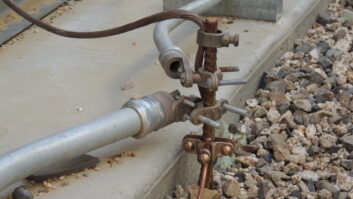An alternative to constructing a transmitter building
Oct 1, 2000 12:00 PM, By Lamar Owen
While investigating a new transmitter building for WGCR, I found that the reinforced, welded rebar sort of construction I wanted for RF shielding was terribly expensive – on the order of $20,000 for just the building. An alternative had to be found to fit our budget.
We found an unlikely solution; sea containers. A sea container is like a semi-trailer without the wheels. In our case, we purchased two refrigerated sea containers from a local container supplier for about $1,000 each. These containers have a fascinating construction. The outside has a heavy corrugated steel shell lined with four to six inches of a high-efficiency insulation. The inside is protected with 16-gauge stainless-steel walls and a ribbed-aluminum floor.
For a foundation, a 12-inch-thick concrete slab was poured, and then six 6-inch angle iron stilts were placed. Then, a plate was welded to the top of each stilt to form a socket for each corner of the containers to sit side by side. The containers were bolted through the sockets to the foundation and then welded. The containers sit 4 feet above the ground.
After the containers were set on the stilts, work began on the electrical and ventilation systems. One container is used for the transmitter and audio container with the electrical panels and entry, and the other houses the generator and storage for tools and other equipment.
While the stainless-steel liner proved tough to drill, it also proved to be an ideal mount for various electrical boxes, panels and the generator transfer switch. All electrical, telephone, cable and RF wiring were routed through a common hole in the transmitter container and then bonded to the liner at point of entry. Heavy copper ground straps were brazed to both containers’ inner and outer shells as close as possible to the point of entry and then bonded to the radial system at the tower base. The solid metal enclosure has provided the ultimate RF shield.
We also found, much to our surprise, that a negative pressure ventilation system, properly ducted, has served very well and allows the doors to seal properly, providing the best insulation for these containers. Conventional wisdom for typical buildings dictates positive pressure, but in this particular unconventional instance, negative pressure seems to work better.
How well has this setup performed once we moved our transmitter in? To say I am pleased with the result would be a major understatement, as mysterious RF troubles I had before are now gone for good.




